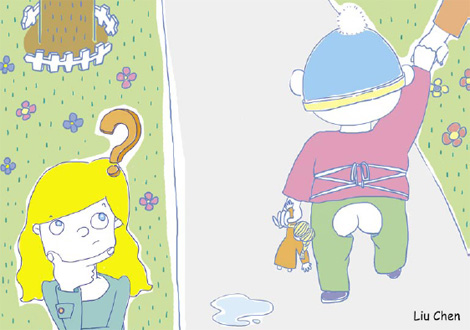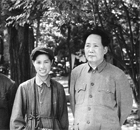Comment
Whistle down wind with split pants
By Qi Zhai (China Daily)
Updated: 2010-02-05 09:29
 |
Large Medium Small |

With the Lunar New Year just around the corner, Beijing's modern facades have undergone yet another transformation. Glass-paneled doors are pasted over with red paper cut-outs of the word fu ("happiness"). Rhyming couplets auguring good fortune are hung around doorways. These festive adornments hark back to a time before skyscrapers, when more of Beijing looked like the last remaining "hutong" inside the Second Ring Road.
As we enter the season of tradition, I'm remembering another iconic image from bygone days: the kai dang ku. Not nearly as ubiquitous as before, the "split pants" are still frequently sighted in warmer seasons, much to the dismay of some Beijing residents. Last August, my friend announced she was leaving Beijing for good with this message on her Facebook homepage: "Farewell to publicly urinating babies!"
She's certainly not the first person to complain about the phenomenon. Despite the waning popularity of crotchless pants, there are still plenty of baby bottoms peeking out at unaccustomed expats. In the older neighborhoods, attentive mothers dot the sidewalk, holding their overexposed toddlers with legs wide open, whistling xuxu.

"What's up with all this?" foreign friends ask me. To satisfy their curiosity and my nostalgia for the traditions of yesteryear, I cobbled together some lesser known facts about split pants.
The idea behind this garment is to give young children the convenience of "going" anywhere, any time, without soiling their clothes, while avoiding diaper rashes. The pants and their accompanying traditional cloth diapers were an economic solution, suitable for virtually every Chinese child. That is until the 1980s brought additional wealth and Pampers to China.
Nowadays, Western and domestic diaper brands line our supermarket shelves. As parents increasingly favor "modern" ways to raise children, the split pant is rapidly disappearing. This change may make for more aesthetic sidewalks, but it also has negative environmental implications.
The cloth to disposable diaper transition took place in developed markets decades earlier. In America, Pampers started selling disposable diapers in 1961 and the product grew hugely popular despite complaints from "greenies".
After learning about the 200,000 trees sacrificed annually to supply the American disposable diaper market, I'm viewing split pants more favorably. Another startling fact I learned is that children raised in this traditional garment complete toilet training years ahead of their Pampers-clad peers.
As developing countries eagerly cast aside their grandmother's ways in favor of store-bought solutions, segments of developed societies are going back to "natural living" methods. Ingrid Bauer, a Western toilet training guru, coined the term "elimination communication" to describe age-old practices she discovered from India to Italy. Her son has been diaper-free (toilet trained) since he was four months old, an experience echoed by many mothers following her advice.
Next time I see a split pant-wearing baby, I'll think twice before wrinkling my nose in disgust. This dying tradition in China is not only affordable but also carries environmental and developmental benefits. Here's hoping that some traditions can last a little longer.









